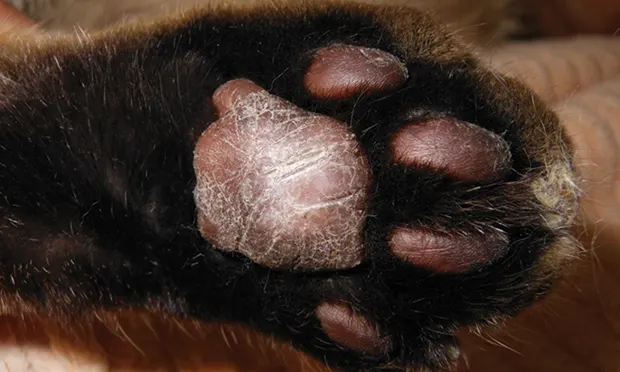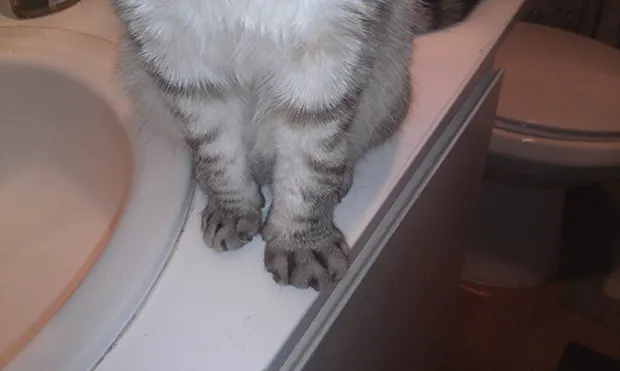Diagnosis & Treatment of Feline Plasma Cell Pododermatitis
Alexander Werner Resnick, VMD, DACVD, Animal Dermatology Center
Amanda Zetwo, DVM, VCA Central

Feline plasma cell pododermatitis (FPP) most commonly causes swelling of the metacarpal pads, metatarsal pads, or digital pads. These signs are followed by hyperkeratosis and ulcerations that may bleed. The majority of cases are diagnosed late in the disease process.
The cause of FPP is unknown, but immune hyperreactivity is suspected based on positive response to immunomodulatory therapy.1,2 Food hypersensitivity has been associated with FPP in some patients, and improvement may be noted with diet trials.*
Seasonal waxing and waning—particularly in spring and summer—have been described, but current studies have not identified an infectious causative agent.3
One study noted that more than half of cats with FPP were FIV-positive; however, viral and/or retroviral association is often not seen.2 There is no reported sex, breed, or age predilection. Presentation varies from a single affected footpad to multiple affected pads on multiple paws. Footpads may be painful, and peripheral lymphadenopathy may be present.
Plasmacytic stomatitis, immune-mediated glomerulonephritis, and renal amyloidosis have been concurrently reported in rare cases.1
Diagnosis
Gross appearance of FPP (Figures 1-3) is generally diagnostic. Cytologic examination of affected pads shows plasma cells with or without lymphocytes and neutrophils.
Hypergammaglobulinemia is a frequent finding. Definitive diagnosis requires examination of a biopsy specimen of the affected pad. Early lesions demonstrate superficial and deep perivascular dermatitis with plasma cells predominating and possibly containing Russell bodies, which are large eosinophilic immunoglobulin- containing inclusions.
The main differential diagnoses include eosinophilic granuloma, pemphigus foliaceus, vasculitis, and acetaminophen toxicosis.

FIGURE 1
Swelling of the digits on both thoracic limbs. Digit 3 of left limb is particularly affected. Pain and lameness were observed.
Treatment
Response can be varied. Some cases resolve spontaneously; others may require courses of treatment with either corticosteroids or cyclosporine. Life-long therapy may be necessary.
In one study,2 doxycycline was reported to produce partial or complete clinical remission in more than half of the cases. This remission is likely caused by immunomodulatory effects, such as inhibition of neutrophil chemotaxis and suppression of phagocytosis and lymphocyte proliferation.
Of note, chronic use of an antibiotic for a reason other than its antimicrobial effect is inconsistent with the principles of prudent antibiotic use.
*Based on anecdotal clinical experience.
Editor’s note: This article was originally published in August 2015 as “Feline Plasma Cell Pododermatitis.”